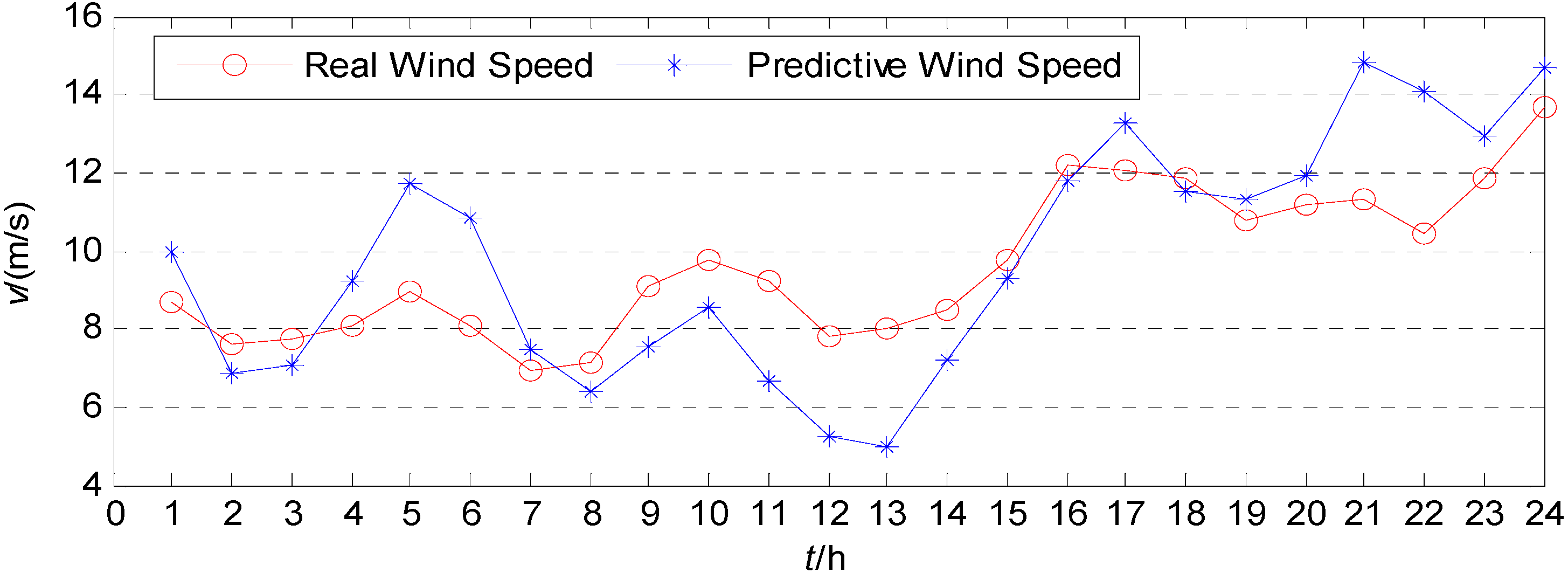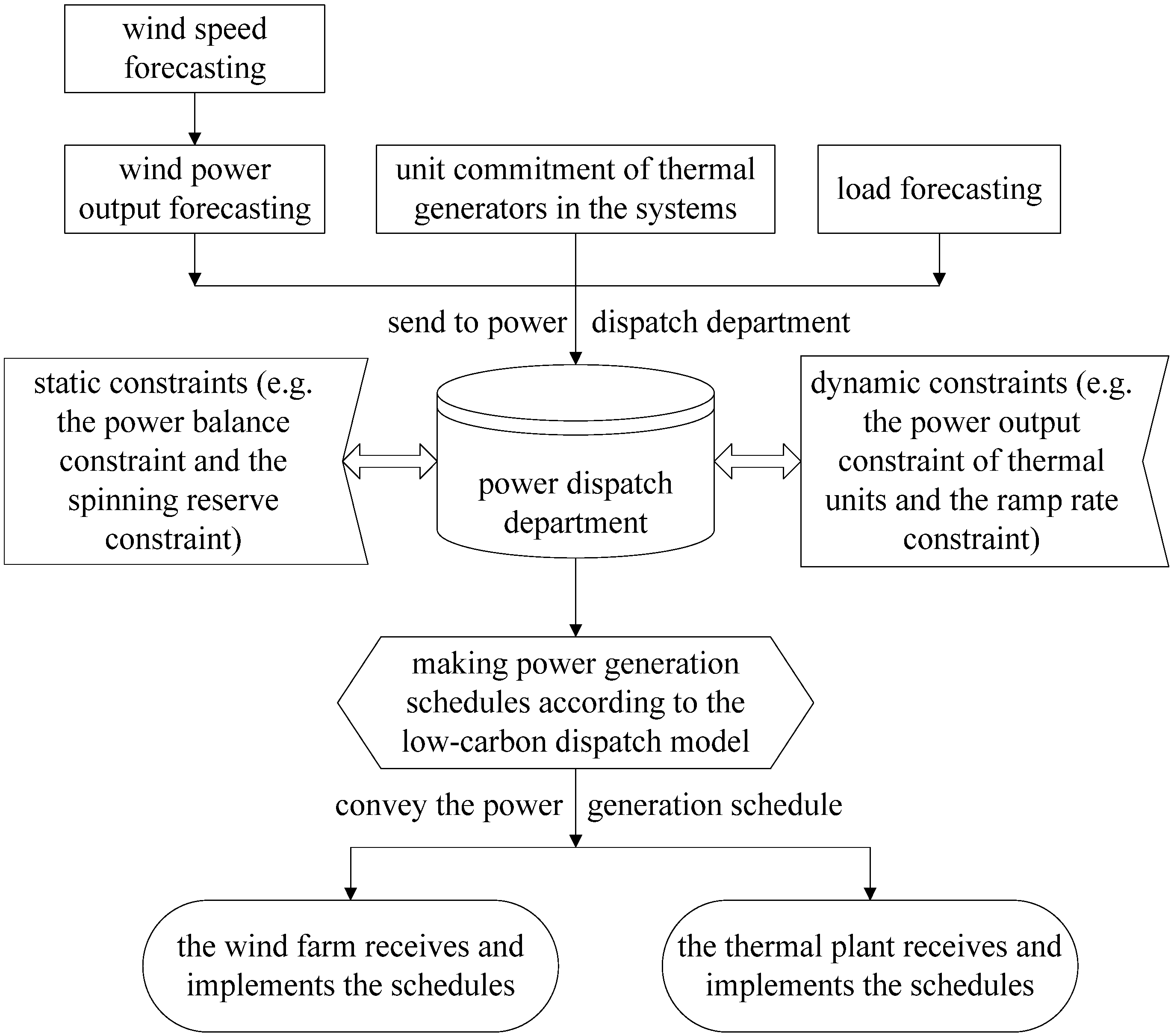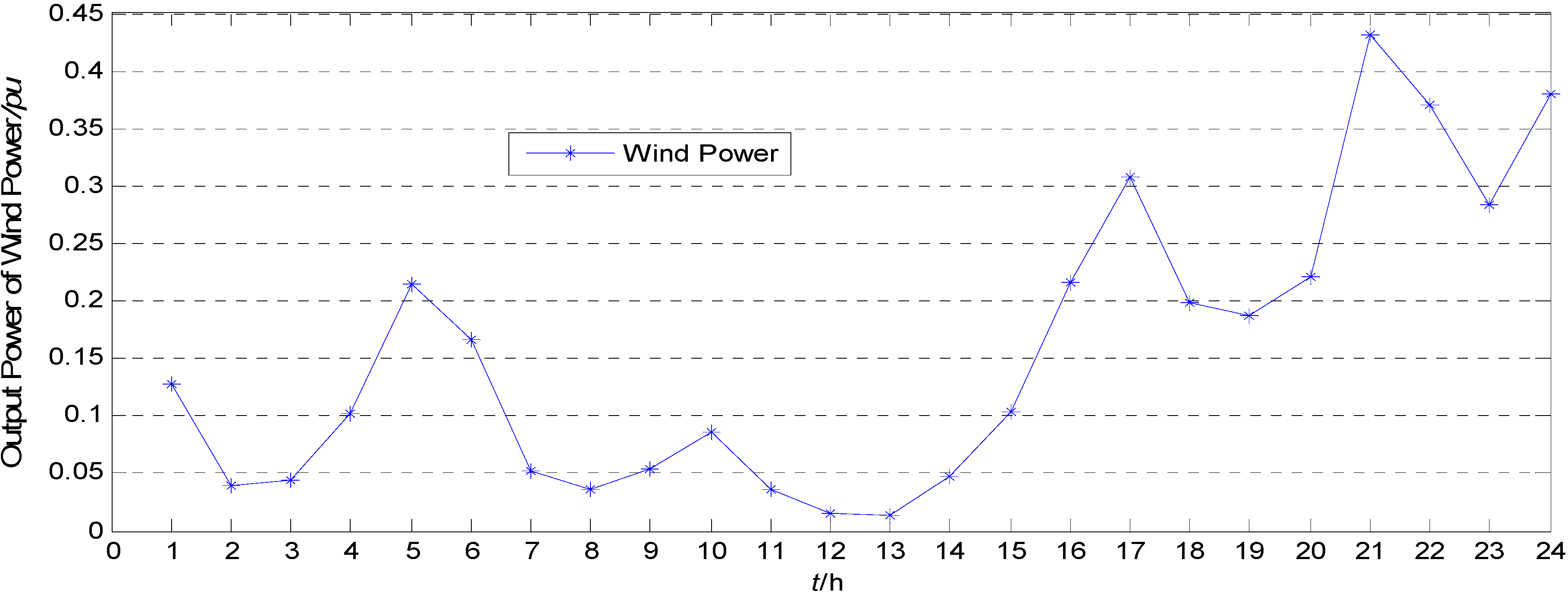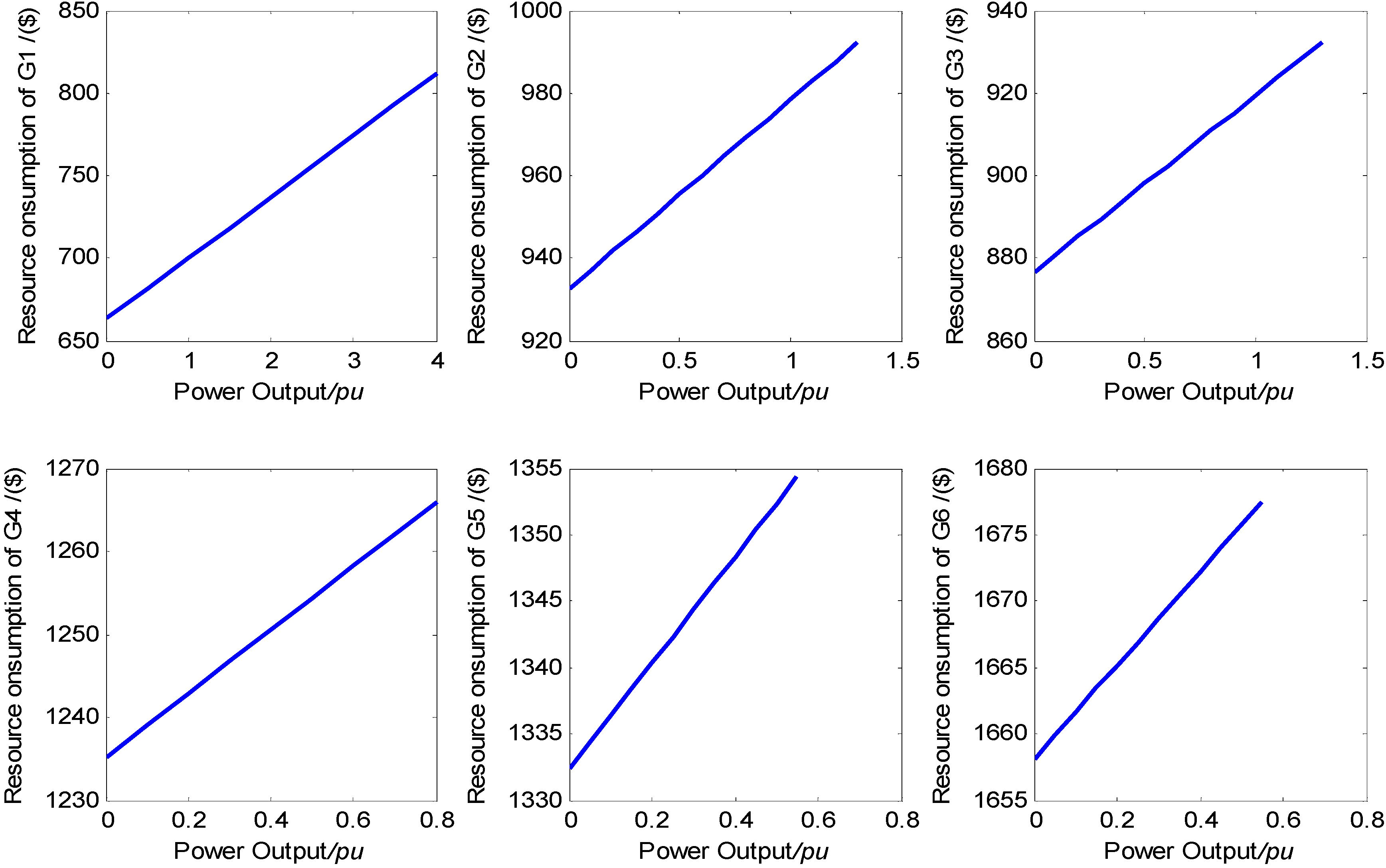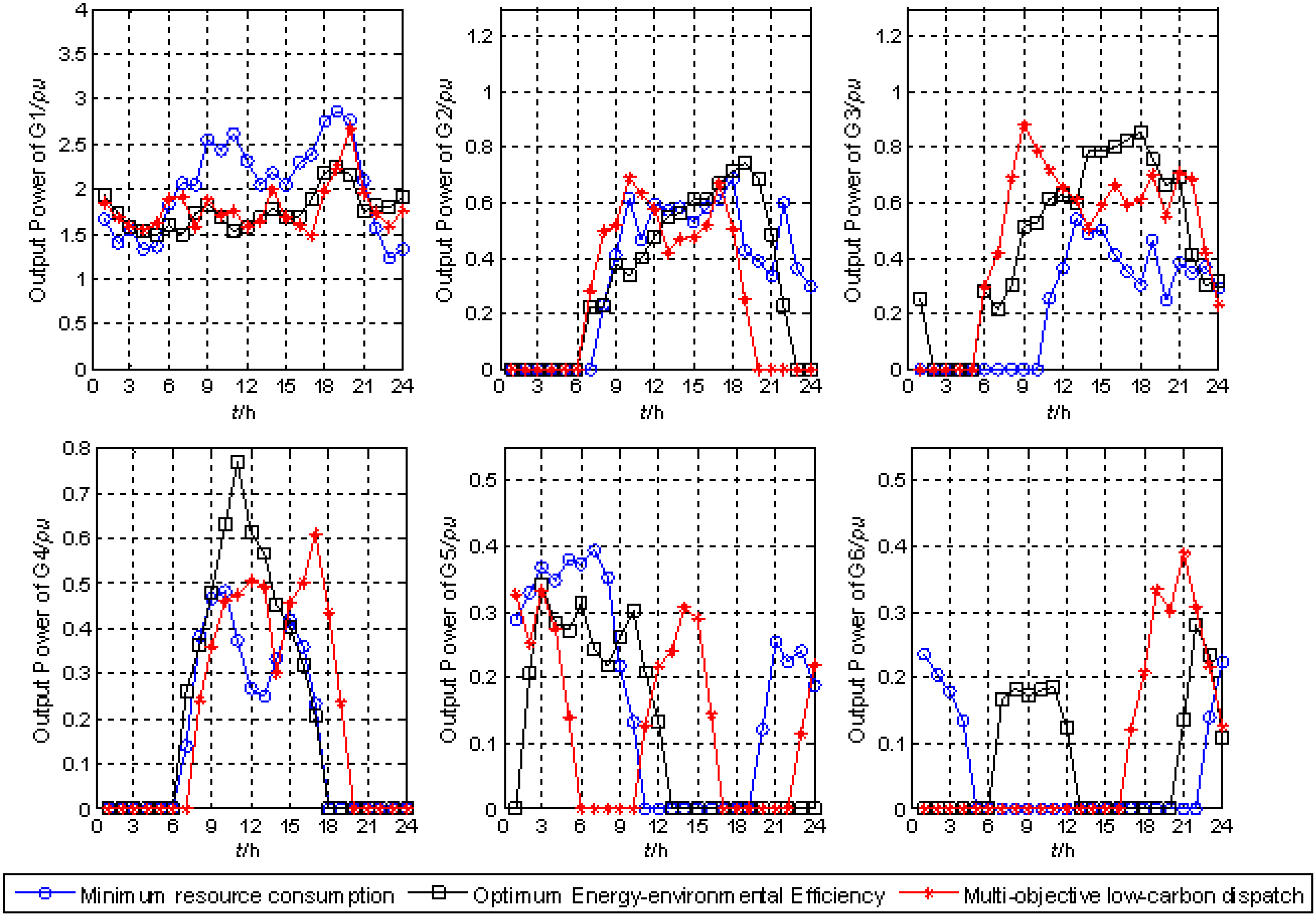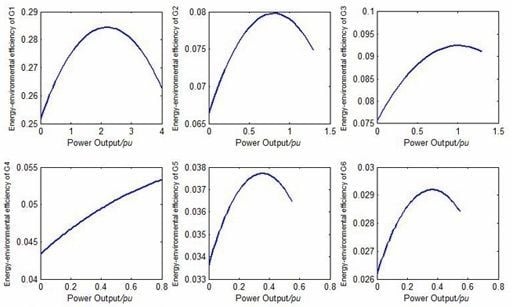1. Introduction
The global energy security and environment situation has become increasingly serious in recent years, leading to a mounting social appeal for environmental protection and sustainable development [
1]. One of the most promising nonpolluting renewable energy sources, wind power, has been given more consideration by policies because of its difference from conventional energy sources [
2]. Wind power in China has developed in leaps and bounds in recent years. The total wind power capacity of China at the end of 2010 has reached 44,734 MW, exceeding the United States for the first time and ranking first in the World [
3]. A zero-emission carbon dioxide renewable resource, wind power is expected to optimize the power source structure, and to promote energy savings and emission reduction in the power industry through large-scale research and development. However, unlike conventional power generation, wind power generation is intermittent and fluctuating. Hence, its integration brings several problems to the power system, dispatch operation being one of the most important aspects [
4,
5,
6,
7].
The intermittent and unpredictable nature of wind power generation can influence generation schedule and frequency control. For this reason, the main method currently used to deal with problems of grid-connected wind power generation is to integrate wind speed forecasting into dispatch operation. Real-time regulation of grid dispatch strategy based on wind speed and wind power forecasting can alleviate the adverse effects caused by wind integration to the grid, increase wind power penetration limits, and reduce power system operation costs. Current wind power forecast methods could be divided into two categories based on energy transformation perspective. The first is indirect methods, which provide wind speed forecasts followed by calculation of the output power of wind farm based on the wind speed-power function curve. The second is direct methods, which directly predict the output power of wind via historical wind power data. Generally, the predicted results will change along with the strength of object regularity. The strength of the regularity of the wind power is weaker than that of the wind speed. Hence, indirect methods can reflect the random fluctuation of wind speed more reasonably than direct methods and are also widely used in wind power prediction. Wind speed forecasting is classified into very short-term, short-term, and medium- and long-term forecasting [
8], The error of very short-term forecasting (on the minutes or seconds range) is generally between 5% and 10% [
9], while short-term forecasting (for the next 24 h) generally has an average prediction error varying from 25% to 40% [
10]. Auto-regressive and moving-average (ARMA), artificial neural network, Kalman filter algorithm, fuzzy logic, and wavelet analysis are the most commonly used methods in wind speed forecasting. However, these methods mainly aim at very short-term forecasting, without considering the time sequence of wind speed data. A fairly accurate short-term forecasting is critical to optimal power system load dispatch. Obtaining such forecasts, typically for the next 24 h, will enable the dispatch department to ensure timely planning and regulation of the dispatch schedule, and thus improve significantly the security and economy of the power system.
The power industry is a major CO
2-emission source, accounting for approximately 40% of the CO
2 emitted by fossil fuel combustion. In many important energy-consuming countries such as the United States, China, and Australia, fossil fuels will serve as the main domestic sources of power generation in the next few decades [
11,
12]. The Kyoto Protocol stipulates that greenhouse gas emission reduction targets must be realized by 2012, which leaves many countries under severe pressure to achieve CO
2 emission reductions. With the deterioration of environmental pollution and the energy crisis, and under the premise of large-scale wind power integration, optimization scheduling can effectively reduce CO
2 emissions, promote low carbon for power production, and promote sustainable development in the power industry.
The traditional power system economic dispatch (ED) is usually aimed at minimum generation operational cost [
13,
14,
15,
16] for economic reasons, overlooking the effect of consequent pollutants on the ecosystem. With increasing public awareness of environmental pollution caused by fossil fuels, the traditional ED cannot satisfy the strategic requirements for sustainable living because of the excessive amount of emission pollution [
17]. As an alternative, the environmental/ED (EED) is becoming increasingly desirable for minimizing cost and emission [
18,
19,
20]. Reference [
21] developed an improved Hopfield neural network for the EED problem. Cai
et al. [
22] solved the EED problems considering both economic and environmental issues using a multi-objective chaotic particle swarm optimization (PSO). Chena and Chen [
23] presented a direct Newton-Raphson method based on an alternative Jacobian matrix to solve the EED problem with line flow constraints. Cheng [
24] proposed a multi-objective dispatch that considers environment and fuel cost under large wind energy. Ummels
et al. [
25] proposed a new simulation method that can fully assess the effects of large-scale wind power on system operations from the cost, reliability, and environmental perspectives.
Based on the ED and EED models, the present paper focuses on the low carbonization of the power system dispatch while maintaining moderate interest in the power generation economy from an ecological perspective. The energy-environmental efficiency concept is introduced into the optimal dispatch of wind-incorporated power systems, for which a low-carbon dispatch model considering unit commitment is built based on wind speed prediction. This paper is organized as follows:
Section 1 provides an introduction.
Section 2 presents the ARMA-based wind speed forecasting approach and the wind speed-power function of wind generators is presented. Data analysis is also conducted on the field wind speed data of a certain wind farm. In
Section 3, a low-carbon dispatch model considering energy-environmental efficiency is described.
Section 4 introduces the basic PSO algorithm and the simulated annealing (SA) algorithms. The PSO with SA (PSO-SA) hybrid algorithm is presented to overcome the inherent defects in the PSO and SA algorithms, and to achieve optimized performance. In
Section 5, the fuzzification method and the concrete calculation steps are pointed out for the aforementioned dispatch model.
Section 6 analyzes the results of a six-generator system containing a wind farm. Finally, conclusions are drawn and discussed in
Section 7.
4. Hybrid of PSO with SA Algorithm
4.1. Basic PSO
The PSO algorithm is an adaptive algorithm originally developed by Kennedy and Eberhart [
33]. PSO is motivated by the social behavior of organisms such as bird flocking. Its main advantages, compared with those of other methods, are its fast and adjustable convergence, and its ability to produce similar yet better quality solutions with less fitness evaluations. The fundamental idea for the PSO is that the optimal solution can be found through cooperation and information sharing among individuals in the swarm. The classical PSO model consists of a swarm of particles moving in the
D-dimensional space of possible problem solutions.
Let
x and
v denote a particle coordinate (position) and its corresponding flight speed (velocity) in the search space. Each particle
i has a position
Xi = (
xi,1,
xi,2, …,
xi,D) and a flight velocity
Vi = (
vi,1,
vi,2, …,
vi,D). Each particle keeps track of its coordinates in the solution space, which is associated with the best solution it has achieved so far. Moreover, a swarm contains for each particle
i its own best position
pi = (
pi,1,
pi,2, …,
pi,D) found so far and a global best particle position
pg = (
pg,1,
pg,2, …,
pg,D) found among all the particles in the swarm so far. The modified velocity and position of each particle can be calculated using the current velocity and the distance from
pbesti,D to
gbesti,D, as shown in the following formulas:
where
N is the number of particles in a group,
D is the number of members in a particle,
ω is an inertia weight factor,
c1 is a cognition weight factor,
c2 is a social weight factor,
rn1 and
rn2 represent uniform random numbers between 0 and 1,
is the
d-th dimension velocity of a particle
i at iteration
k,
is the
d-th dimension position of particle
i at iteration
k,
is the
d-th dimension position of the own best position of particle
i until iteration
k, and
is the
d-th dimension of the best particle in the swarm at iteration
k.
4.2. SA Algorithm
The SA algorithm was proposed by Kirkpatrick
et al. in 1983 [
34]. SA is one of the most efficient methods for solving widely complex problems with several solution combinations. The basic idea of the method is that it accepts all changes that lead to improvements in the fitness of a solution to avoid becoming trapped in local minima. This technique is a reassertion of the gradual cooling process of a physical system to reach the state of minimum potential energy. The SA process consists of two steps. One is to increase the temperature of the heating bath to a maximum value at which the solid melts, and the other is to decrease the temperature of the heating bath gradually until the particles arrange themselves in the ground state of the solid [
35].
SA is an improving mechanism that starts with a primary solution (S0). The parameter that controls the process is temperature (T), which takes an initial value of T0. Subsequently, in the solution space, other solutions are searched in the following manner.
The temperature (
T) declines gradually during the calculation process, and the solution is evaluated by the Metropolis rule continually [
36]. In each stage of the reduction, the process stops to reach a thermal equilibrium, which represents a better solution. During this time, a new solution (
Sn) is created in the neighborhood of the previous solution (
S). If the value of objective function [
f(
Sn)] is less than that of the previous value [
f(
S)], for example, for a minimum optimization problem, then the new solution is accepted. Otherwise, the new solution is accepted with a probability of
P to escape the local optimum [
37].
P is calculated by the formula:
where Δ
E is the change in value and
K is the Boltzmann constant.
SA can receive a worse solution limitary according to the Metropolis rule when the temperature is high. Hence, it can escape the local solution and have a good global convergence performance. However, the performance of the SA algorithm largely depends on the initial solution (S0). The precondition of global convergence is that the initial temperature is high enough, declines slowly enough, and has an ending temperature that is low enough.
4.3. PSO-SA Hybrid Algorithm
PSO is simple and convenient, but it is easily trapped in the local optimization. SA has a strong ability to avoid the problem of local optimization, but its convergence rate is slow. Taking into consideration the characteristics of the SA and PSO algorithms, the present paper presents a novel combined algorithm based on PSO and SA [
38,
39]. The basic idea of the PSO-SA is to learn from one algorithm’s strong points to offset the other’s weaknesses. Regarding PSO as the principal part of the hybrid strategy, first the initial swarm is generated randomly. Subsequently, new individuals are searched [
40]. Meanwhile, the annealing operation is used to update the position and velocity of each particle. In the PSO-SA hybrid algorithm, the inertia weight
ω starts with a high value
ωmax and linearly decreases to
ωmin. For the acceleration coefficients,
c1 and
c2 start with a high value
cmax and decrease to
cmin. The mechanical expression is as follows:
where
itermax is the maximum iteration number,
iter is the current iteration number,
ωmax is set to 0.9,
ωmin is set to 0.4 by experiment,
cmax is set to 2.0, and
cmin is set to 0.8.
The procedures for implementing the PSO-SA hybrid algorithm are given by the following steps:
Step 1: Create a swarm of particles as the initial population of PSO, including random position and velocity, and calculate the experienced best position Pbest = (p1, p2, …, pi, …, pN), the global best position pg.
Step 2: Initialize the sequence number of iteration k = 0.
Step 3: Calculate the ω(k), c1(k), and c2(k) according to Equations (28) and (29).
Step 4: Update the position and velocity of every particle in the population according to Equations (25) and (26).
Step 5: Update the X, V, pi, and pg of the population.
Step 6: k = k + 1, if k ≥ itermax, go to Step 7; otherwise, go back to Step 3.
Step 7: According to the obtained Pbest, take each pi as a starting state using SA to find the optimum pg. Initialize the sequence number of initial solutions i = 1, and the temperature controlling parameter T = T0.
Step 8: Generate a new solution pitemp according to pi. If f(pitemp) < f(pi), accept pitemp to replace pi; otherwise, calculate P from Equation (27), generate a random number rntemp between 0 and 1. If rntemp < P, accept pitemp to replace pi; otherwise, do nothing.
Step 9: Decrease the temperature by the formula T = α × T, where α is called the cooling coefficient, with 0.80 ≤ α ≤ 1.0. If T > Tmin, go back to Step 8; otherwise, go to Step 10. At the end of Step 9, a new population = (p1,temp, p2,temp, …, pi,temp, …, pN,temp) is obtained.
Step 10: Choose the solution with the best objective function value from . Estimate the solution. If it is satisfactory, output the solution and end the calculation; otherwise, go back to Step 4.
6. Numerical Simulation
To confirm the reasonability of the low-carbon power dispatch model considering the energy-environmental efficiency and the practicability of the PSO-SA algorithm, a six-unit system is introduced to implement the simulation in a 24 h dispatch period (1 h per time interval). The “Renewable Energy Law” promulgated by China has set policies to support renewable energy being fully online. This numerical simulation first meets the full online need of wind power forecasting. Wind power will still run according to the prediction when the system load demand is increased or decreased, and the change of the load value is borne by the thermal power units. One wind farm is incorporated with 60 wind turbines, rated 750 kW power output, and 3 m/s, 25 m/s, and 15m/s for the cut-in wind speed, cut-out wind speed, and rated wind speed, respectively. The relevant data of the wind farm comes from the actual running wind farm in Yunnan Province, China. Considering the small system capacity of wind power farms and the limited power of wind forecasting in the 24 h dispatching periods, the reserve requirements based on present-day values is prescribed as 5% of the load. The control parameters of the PSO-SA algorithm are expressed as follows: population size = 20, maximum iteration number = 200, start temperature
T = 100, terminate temperature
T0 = 50, and cooling coefficient
α = 0.95. The base value of power is set as 100 MVA. The system load statistics are shown in
Table 2. The conventional generator parameters are shown in
Table 3, in which the first generator serves as the balancing unit. Fuel specifications are listed in
Table 4. The codes are compiled using Matlab R2010a under the computing environment of Intel(R) Core(TM)i3 2120 3.3 GHz, 4 GB RAM.
Table 2.
Load demands.
| Hour | 1 | 2 | 3 | 4 | 5 | 6 | 7 | 8 | 9 | 10 | 11 | 12 |
|---|
| PD/pu | 2.305 | 1.963 | 1.958 | 1.909 | 1.958 | 2.359 | 2.650 | 3.041 | 3.685 | 3.736 | 3.736 | 3.548 |
| Hour | 13 | 14 | 15 | 16 | 17 | 18 | 19 | 20 | 21 | 22 | 23 | 24 |
| PD/pu | 3.412 | 3.613 | 3.592 | 3.636 | 3.875 | 3.932 | 3.932 | 3.736 | 3.486 | 3.093 | 2.608 | 2.706 |
Table 3.
Parameters of conventional generators.
Table 3.
Parameters of conventional generators.
| Unit NO. | G1 | G2 | G3 | G4 | G5 | G6 |
|---|
| Pimax/pu | 4.00 | 1.30 | 1.30 | 0.80 | 0.55 | 0.55 |
| Pimin/pu | 1.20 | 0.20 | 0.20 | 0.20 | 0.10 | 0.10 |
| ai/($/h) | 663.3562 | 932.6582 | 876.7851 | 1235.2237 | 1332.3704 | 1658.1029 |
| bi/($/MW·h) | 0.3619 | 0.4560 | 0.4258 | 0.3826 | 0.3992 | 0.3527 |
| ci/(10−4·$/MW2·h) | 0.2048 | 0.1332 | 0.1298 | 0.0640 | 0.0254 | 0.0128 |
| riup/(pu/h) | 0.8 | 0.3 | 0.3 | 0.25 | 0.15 | 0.15 |
| ridown/(pu/h) | 0.8 | 0.3 | 0.3 | 0.25 | 0.15 | 0.15 |
| ηie | 0.75 | 0.50 | 0.55 | 0.40 | 0.35 | 0.30 |
| αi/10−5·MW−2 | −0.0313 | −0.2495 | −0.1875 | −0.1210 | −0.7503 | −0.6714 |
| βi/10−2·MW−1 | 0.1375 | 0.4017 | 0.3775 | 0.3228 | 0.5301 | 0.4866 |
| γi | 0.8300 | 0.7466 | 0.7795 | 0.7496 | 0.7472 | 0.7520 |
| Si/$ | 4500 | 560 | 550 | 170 | 30 | 30 |
| /h | 8 | 5 | 5 | 3 | 1 | 1 |
| /h | 8 | 5 | 5 | 3 | 1 | 1 |
Table 4.
Fuel characteristic data of unit.
Table 4.
Fuel characteristic data of unit.
| Unit NO. | EiCO2 | /(MJ/kg) |
|---|
| G1 | 23.933 2 | 25.862 7 |
| G2 | 38.952 9 | 14.872 6 |
| G3 | 34.212 6 | 13.071 4 |
| G4 | 40.593 3 | 12.288 0 |
| G5 | 42.015 2 | 11.191 7 |
| G6 | 44.128 2 | 10.530 3 |
The predicted power output
Pw of the wind farm in the 24 dispatch periods shown in
Figure 5 is based on the wind speed–power function curve described in Equations (12) and (13), and the wind speed prediction in
Figure 2.
Table 5 compares the optimization results of the wind farm integrated into the system and the wind farm not integrated into the system power dispatch model. The energy-environmental efficiencies of the two models show no clear distinction due to low power output of the wind farm, whereas the operational cost experienced a decrease of $5,512.6268, from $99,721.9382 to $94,209.3114. Thus, the incorporation of wind power reduces primary energy cost, which proves to be a significant advantage of wind power.
Figure 5.
Wind power forecast data for each time period.
Figure 5.
Wind power forecast data for each time period.
Table 5.
Comparison between optimization results of wind farmin and out the power system of low-carbon dispatch models.
Table 5.
Comparison between optimization results of wind farmin and out the power system of low-carbon dispatch models.
| Dispatch model | Operational cost/($) | Energy-environmental efficiency |
|---|
| Wind farm excluded | 99,721.9382 | 10.9417 |
| Wind farm included | 94,209.3114 | 10.9301 |
Table 6 lists the comparison of computation times of multi-objective low-carbon dispatch and different single-objective dispatch models. As shown in
Table 6, the calculation time consumed in solving multi-objective low-carbon dispatch model in a system consisting of six thermal power units and a grid-connected wind farm is 834.8493 s, which is longer than the time consumed in solving the single-objective dispatch model. Increased calculation time shows that the multi-objective model is more complicated and more difficult than the single-objective model. In the actual operation of the power system, the scheduling department generally makes power generation plan 24 h ahead of time. Therefore, the computing efficiency of the PSO-SA algorithm used in this paper to solve multi-objective low-carbon models can still meet the demand of the dispatch department to make daily generation plan. The PSO-SA algorithm used in this paper can act as a reasonable candidate for scheduling solution of the scheduling department of the power system.
Table 6.
Comparison of calculation times of multi-objective and different single-objective dispatch models.
Table 6.
Comparison of calculation times of multi-objective and different single-objective dispatch models.
| Dispatch model | Minimum operational cost | Optimum energy-environmental efficiency | Multi-objective low-carbon dispatch |
|---|
| CPU time/(s) | 289.1735 | 349.4854 | 834.8493 |
Table 7 compares the expected optimization objectives of the multi-objective low-carbon dispatch model with those of the single-objective dispatch models.
Table 8 reveals the fuzzification result of the multi-objective dispatch model.
Figure 6 shows the resource consumption-thermal power output curve.
Figure 7 depicts the energy-environmental efficiency-thermal power output curve.
Figure 8 renders the unit commitment and power output curves of the thermal generators, G
1 to G
6, of different dispatch models.
Table 7.
Comparison of optimization results among multi-objective and different single-objective dispatch models.
Table 7.
Comparison of optimization results among multi-objective and different single-objective dispatch models.
| Objective | Minimum operational cost | Optimum energy-environmental efficiency | Multi-objective low-carbon dispatch |
|---|
| Operational cost/($) | 91,642.8250 | 97,312.1739 | 94,209.3114 |
| Energy-environmental efficiency | 10.5646 | 11.0364 | 10.9301 |
Table 7 and
Table 8 show a maximum satisfaction value of 0.8122 when the multi-objective low-carbon dispatch optimization is performed, as shown in
Table 8. Under this circumstance, generation operational cost is $94,209.3114, a $2,566.4864 (2.8%) increase compared with the operational cost of $91,642.8250 in the minimum operational cost dispatch and a $3,102.8625 (3.18%) reduction compared with the operational cost of $97,312.1739 in the optimum energy-environmental efficiency dispatch.
Table 8.
Fuzzification result of multi-objective low-carbon dispatch model.
Table 8.
Fuzzification result of multi-objective low-carbon dispatch model.
| λ | μ(F) | μ(E) | F/($) | E |
|---|
| 0.6373 | 0.9113 | 0.6373 | 92,432.7848 | 10.6894 |
| 0.6536 | 0.9026 | 0.6536 | 92,805.9495 | 10.7092 |
| 0.7138 | 0.8878 | 0.7138 | 93,109.7942 | 10.7752 |
| 0.7192 | 0.8825 | 0.7192 | 93,372.6540 | 10.7828 |
| 0.7513 | 0.8759 | 0.7513 | 93,605.9495 | 10.8252 |
| 0.7657 | 0.8562 | 0.7657 | 93,688.7945 | 10.8429 |
| 0.7741 | 0.8513 | 0.7741 | 93,935.8975 | 10.8763 |
| 0.7997 | 0.8489 | 0.7997 | 94,054.6232 | 10.8892 |
| 0.8050 | 0.8216 | 0.8050 | 94,117.0730 | 10.9102 |
| 0.8122 | 0.8158 | 0.8122 | 94,209.3114 | 10.9301 |
The corresponding energy-environmental efficiency value of the best compromise solution equals 10.9301, which is a 0.1063 (0.96%) decrease from 11.0364 of the optimum energy-environmental efficiency dispatch and a 0.3655 (3.46%) increase from 10.5646 of the minimum operational cost dispatch. According to
Table 7, optimization of the multi-objective low-carbon dispatch model bears higher total generation operational cost than that of the optimization of minimum operational cost dispatch model and better energy-environmental efficiency than that of the optimization of the optimum energy-environmental efficiency dispatch model. The multi-objective model accounts for both economy and ecology in power generation, whereas the pre-mentioned single-objective models emphasize only a certain side. Based on the above comparative analysis, the multi-objective dispatch model proposed in the present paper outperforms the single-objective ones when the two conflicting optimization objectives are both considered. The proposed model strikes a balance between the two and precisely reflects the operating condition of the thermal generators while optimizing the wind power output dispatch. These characteristics distinguish the proposed model from the traditional single-objective ones.
Table 8 indicates that operational cost increases along with the enhancement of fuzzy satisfaction, whereas the energy-environmental efficiency increases greatly. Nevertheless, control of CO
2 emission is bound to raise generation costs. This finding further proves the necessity and efficiency of the proposed model in improving energy-environmental efficiency and cutting down carbon emission. The decision maker can choose a compromise solution subjectively to meet different power market requirements based on the optimization result.
Figure 6.
Curves of resource consumption values of unit G1 to G6.
Figure 6.
Curves of resource consumption values of unit G1 to G6.
Figure 6 shows that the resource consumption values of the six generators increase monotonously with the escalation of power output level. The operational cost of thermal unit is determined by resource consumption. This characteristic leads to the active power of all thermal generator units in different dispatching periods close to the relevant power output value of the minor resource consumption when using the objective function of minimum operational cost in optimal dispatching. Besides, those with minor resource consumption in the same load distribution have the priority to take the load. Nevertheless, the energy-environmental efficiency curve and the resource consumption curve show different characteristics.
Figure 7 shows the energy-environmental efficiency values of the six generators under different power output levels. The energy-environmental efficiency of the thermal generators does not monotonically increase along with the escalation of the power output, except in the fourth unit. They generally have parabolic curves that make energy-environmental efficiency values lower on both light and heavy power output levels. This characteristic significantly influences the load dispatch strategy when considering energy-environmental efficiency. For a certain generator, power output in different dispatch periods converges to the point where the energy-environmental efficiency reaches its optimum value. For generators with the same power output character, those with better energy-environmental efficiency have the priority to take the load.
Figure 7.
Curves of energy-environmental efficiency values of unit G1 to G6.
Figure 7.
Curves of energy-environmental efficiency values of unit G1 to G6.
The abovementioned issue may be proven by the power output curves in
Figure 8. In either single-objective model with optimal energy-environmental efficiency or multi-objective low-carbon dispatch model to carry out the dispatch, the power output of the thermal generators fluctuates around the point of the best energy-environmental efficiency in most dispatch intervals. When the load is relatively low, units with worse energy-environmental efficiency will be cut off. This way, the overall energy-environmental efficiency is improved because the units with better energy-environmental efficiency are ensured to operate around their optimum operation point. When the minimum operational cost model is adopted, the power output of G
1 to G
6 are reduced for cost control, resulting in a relatively low energy-environmental efficiency value. Under this circumstance, operational cost is lessened at the expense of environmental damage, contrary to the low-carbon developing policy. For generators of the same power output characteristic, the ones with better energy-environmental efficiency will take on the load first. For example, if G
2 and G
3 have the same power output character, as shown in
Figure 7, then G
3 exceeds G
2 in operating time and power output when energy-environmental efficiency is considered. A similar analysis applies to G
5 and G
6 with an identical conclusion.
The energy-environmental efficiency curve of G4 monotonically increases with the growth of its power output. A comparison of the power output curves of G4 in the three different dispatch models suggests that G4 offers the largest power output in the optimum energy-environmental efficiency model. In the multi-objective model, the power output of G4 falls to some extent, but still outweighs the power output in the minimum operational cost model significantly. Therefore, the above comparative analysis reveals that the unit commitment strategy and load dispatch scheme change greatly when energy-environmental efficiency is considered. Units with better energy-environmental efficiency gain the priority to be loaded to augment the operational cost of power generation. When the multi-objective low-carbon dispatch model is introduced, reasonable operational cost is achieved while energy-environmental efficiency is improved and low-carbon dispatch is promoted.
Figure 8.
Curves of daily output of units G1 to G6 with different objectives.
Figure 8.
Curves of daily output of units G1 to G6 with different objectives.
Figure 8 shows that in the optimization of the minimum operational cost model, units with lower operational cost possess absolute advantage in price regardless of the energy-environmental efficiency. Thus, these units hold loading priority. When energy-environmental efficiency serves as the optimization objective, units with better energy-environmental efficiency have superiority over other generators, irrespective of operational cost. Thus, such units hold loading priority. When both economic and environmental indexes are considered, optimization of the multi-objective model involves the impartiality for power generators and brings forward the spirit of low-carbon power dispatch.
Energy-environmental efficiency cannot be measured by money like the operational cost of traditional generators. Rather, it appears as a kind of invisible capital. Overall, by taking energy-environmental efficiency into account, the operational cost of thermal generators slightly increases, whereas the energy-environmental efficiency of the power generation system escalates unconsciously, leaving the ecology less polluted. Therefore, incorporation of the energy-environmental efficiency into the power dispatch model bears profound meanings in the background of global promotion of green energy development and low-carbon economy. Low-carbon dispatch possesses expansive potential applications in appliances.

